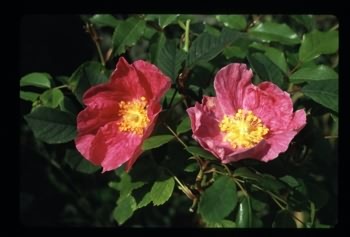Relatives
Rosa gallica L. - French rose
Taxonomic position.
Family Rosaceae Juss. genus Rosa L.Synonyms.
Rosa austriaca Crantz, R.pumila Jacq., R.rubra Lam., R.pygmaea Bieb., R.czackiana Bess., R.bugensis Chrshan., R.crenulata Chrshan., R.heteracantha Chrshan., R.minimalis Chrshan., R.parviuscula Chrshan.& Laseb., R.tauriae Chrshan.Morphology and biology.
Deciduous dwarf shrub with decumbent shoots more than 2 m long and ascendant or erect floriferous stems (50-100 cm). Branches and shoots are covered with numerous short glandular setae and more sparsely with subulate or falcately curved flattened thorns. Leaves are compound, imparipinnate, 4.5-12.5 cm long, consisting of 3-5-7 leaflets. Leaflets are oblong-elliptic or orbed, leathery, with expressly projecting veins from below, glandular-serrate with broad denticles along the edges. Stipules are narrow, glandular along the edges, accreted with the petiole. Pedicels are long, 1.8-5 cm in length, thick, covered with stalk-like glandules. Sepals are broadened at the tip, strongly pinnate, glandular on the back, greatly deflected after flowering. Flowers are single. Corollas are dark- or light-pink, red, 4-6 cm in diameter. Petals are longer than the sepals, sinuate. The fruit is a multi-nut inside an effuse hypanthium, which becomes fleshy and forms the cover of a pseudocarp. Fruits are approximately 1.5 cm long, globular or ovoid, brown-red. This species is entomophilous. It can be ornito- and zoochore. It is propagated by seed and cuttings. Blossoms in June-July; fruits ripen in August-September. Chromosome number: 2n=14.Distribution.
This species grows in Moldova, Ukraine, Crimea, Ante-Caucasus, West Transcaucasia, Talysh, Central Europe, the Mediterranean region, and Asia Minor.Ecology.
Speices is a mesophyte; light-demanding and facultative calcephyte. It grows on forest edges and glades, steppe rubble slopes and limestone outcrops, more frequently among bushes. It is a typical plant of oak wood edges. Quite often develops rather extensive thickets.Utilization and economic value.
It is used as a food, ornamental, melliferous and medicinal plant. Fruits are used to prepare jams and candies. In Germany a special drink is made from its seed fried with sugar. It is recommended for utilization in landscaping.Reference citations:
Randushka D., Shomshak L. and Gaberova I. 1990. Colour atlas of plants. Bratislava: Obzor Publishers. 276 p. (In Russian)Sokolov S.I., Svjaseva O.A., Kubli V.A. 1980. Areas of distribution of trees and shrubs in the USSR. V. 2. Leningrad: Nauka. 92 p. (In Russian)
Yuzepchuk, S.V. 1941. Rose (wild rose)-Rosa L. Flora of the USSR. V. 10. Moscow-Leningrad: Publishing House of the USSR Academy of Sciences. 483-484 p. (In Russian)


